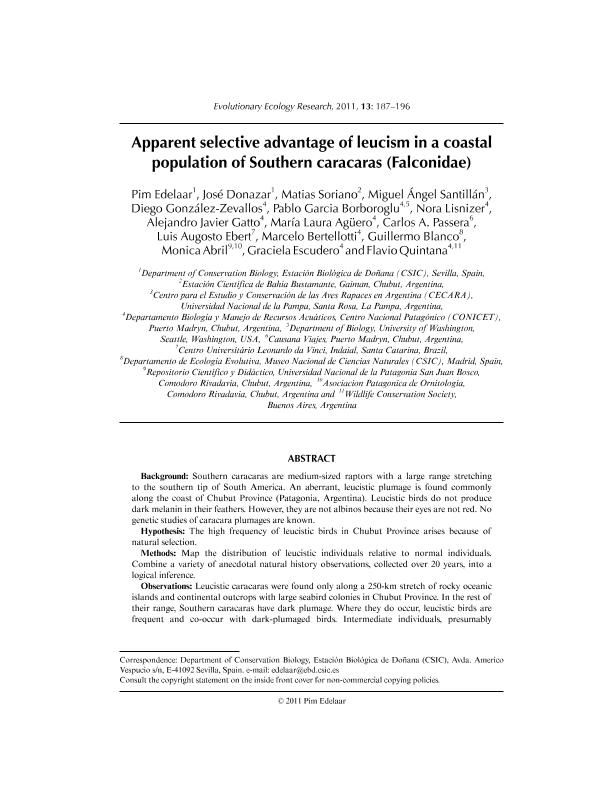Mostrar el registro sencillo del ítem
dc.contributor.author
Edelaar, Pim
dc.contributor.author
Donazar, José
dc.contributor.author
Soriano, Matías
dc.contributor.author
Santillan, Miguel Angel

dc.contributor.author
Gonzalez Zevallos, Diego Ricardo

dc.contributor.author
Garcia Borboroglu, Jorge Pablo

dc.contributor.author
Lisnizer, Nora

dc.contributor.author
Gatto, Alejandro Javier

dc.contributor.author
Agüero, Maria Laura

dc.contributor.author
Passera, Carlos A.
dc.contributor.author
Ebert, Luis Augusto
dc.contributor.author
Bertellotti, Néstor Marcelo

dc.contributor.author
Blanco, Guillermo

dc.contributor.author
Abril, Monica
dc.contributor.author
Escudero, Graciela

dc.contributor.author
Quintana, Flavio Roberto

dc.date.available
2020-01-06T20:45:37Z
dc.date.issued
2011-05
dc.identifier.citation
Edelaar, Pim; Donazar, José; Soriano, Matías; Santillan, Miguel Angel; Gonzalez Zevallos, Diego Ricardo; et al.; Apparent selective advantage of leucism in a coastal population of Southern caracaras (Falconidae); Evolutionary Ecology; Evolutionary Ecology Research; 13; 5-2011; 187-196
dc.identifier.issn
1522-0613
dc.identifier.uri
http://hdl.handle.net/11336/93717
dc.description.abstract
Background: Southern caracaras are medium-sized raptors with a large range stretching to the southern tip of South America. An aberrant, leucistic plumage is found commonly along the coast of Chubut Province (Patagonia, Argentina). Leucistic birds do not produce dark melanin in their feathers. However, they are not albinos because their eyes are not red. No genetic studies of caracara plumages are known. Hypothesis: The high frequency of leucistic birds in Chubut Province arises because of natural selection. Methods: Map the distribution of leucistic individuals relative to normal individuals. Combine a variety of anecdotal natural history observations, collected over 20 years, into a logical inference. Observations: Leucistic caracaras were found only along a 250-km stretch of rocky oceanic islands and continental outcrops with large seabird colonies in Chubut Province. In the rest of their range, Southern caracaras have dark plumage. Where they do occur, leucistic birds are frequent and co-occur with dark-plumaged birds. Intermediate individuals, presumably heterozygotes, exist. Leucism is not related to age or sex. Leucistic individuals are restricted to a particular habitat. Gene flow has not homogenized the coastal and inland populations. Results: Leucism is not simply due to inbreeding producing more homozygous individuals. Leucism is not due to genetic drift. Leucism is not an environmental effect on individual physiology or development. Leucism is not a transient (plastic) phenomenon. Where they occur frequently, leucistic Southern caracaras are apparently favoured by natural selection, either directly or by pleiotropy.
dc.format
application/pdf
dc.language.iso
eng
dc.publisher
Evolutionary Ecology

dc.rights
info:eu-repo/semantics/openAccess
dc.rights.uri
https://creativecommons.org/licenses/by-nc-sa/2.5/ar/
dc.subject
Southern Caracara
dc.subject
Leucistic Plumage
dc.subject
Patagonia
dc.subject.classification
Otros Tópicos Biológicos

dc.subject.classification
Ciencias Biológicas

dc.subject.classification
CIENCIAS NATURALES Y EXACTAS

dc.title
Apparent selective advantage of leucism in a coastal population of Southern caracaras (Falconidae)
dc.type
info:eu-repo/semantics/article
dc.type
info:ar-repo/semantics/artículo
dc.type
info:eu-repo/semantics/publishedVersion
dc.date.updated
2019-09-20T15:12:05Z
dc.journal.volume
13
dc.journal.pagination
187-196
dc.journal.pais
Estados Unidos

dc.description.fil
Fil: Edelaar, Pim. Consejo Superior de Investigaciones Científicas. Estación Biológica de Doñana; España
dc.description.fil
Fil: Donazar, José. Consejo Superior de Investigaciones Científicas. Estación Biológica de Doñana; España
dc.description.fil
Fil: Soriano, Matías. Estación Científica de Bahía Bustamante; Argentina
dc.description.fil
Fil: Santillán, Miguel Angel. Universidad Nacional de La Pampa. Facultad de Ciencias Exactas y Naturales. Departamento de Recursos Naturales; Argentina
dc.description.fil
Fil: Gonzalez Zevallos, Diego Ricardo. Consejo Nacional de Investigaciones Científicas y Técnicas. Centro Nacional Patagónico; Argentina
dc.description.fil
Fil: Garcia Borboroglu, Jorge Pablo. Consejo Nacional de Investigaciones Científicas y Técnicas. Centro Nacional Patagónico; Argentina
dc.description.fil
Fil: Lisnizer, Nora. Consejo Nacional de Investigaciones Científicas y Técnicas. Centro Nacional Patagónico; Argentina
dc.description.fil
Fil: Gatto, Alejandro Javier. Consejo Nacional de Investigaciones Científicas y Técnicas. Centro Nacional Patagónico; Argentina
dc.description.fil
Fil: Agüero, Maria Laura. Consejo Nacional de Investigaciones Científicas y Técnicas. Centro Nacional Patagónico; Argentina
dc.description.fil
Fil: Passera, Carlos A.. Causana Viajes; Argentina
dc.description.fil
Fil: Ebert, Luis Augusto. Centro Universitario Leonardo Da Vinci (uniasselvi); Brasil
dc.description.fil
Fil: Bertellotti, Néstor Marcelo. Consejo Nacional de Investigaciones Científicas y Técnicas. Centro Nacional Patagónico; Argentina
dc.description.fil
Fil: Blanco, Guillermo. Consejo Superior de Investigaciones Cientificas. Museo Nacional de Ciencias Naturales; España
dc.description.fil
Fil: Abril, Monica. Universidad Nacional de la Patagonia "San Juan Bosco"; Argentina
dc.description.fil
Fil: Escudero, Graciela. Consejo Nacional de Investigaciones Científicas y Técnicas. Centro Nacional Patagónico; Argentina
dc.description.fil
Fil: Quintana, Flavio Roberto. Consejo Nacional de Investigaciones Científicas y Técnicas. Centro Nacional Patagónico; Argentina
dc.journal.title
Evolutionary Ecology Research

dc.relation.alternativeid
info:eu-repo/semantics/altIdentifier/url/http://www.evolutionary-ecology.com/abstracts/v13/2639.html
Archivos asociados
